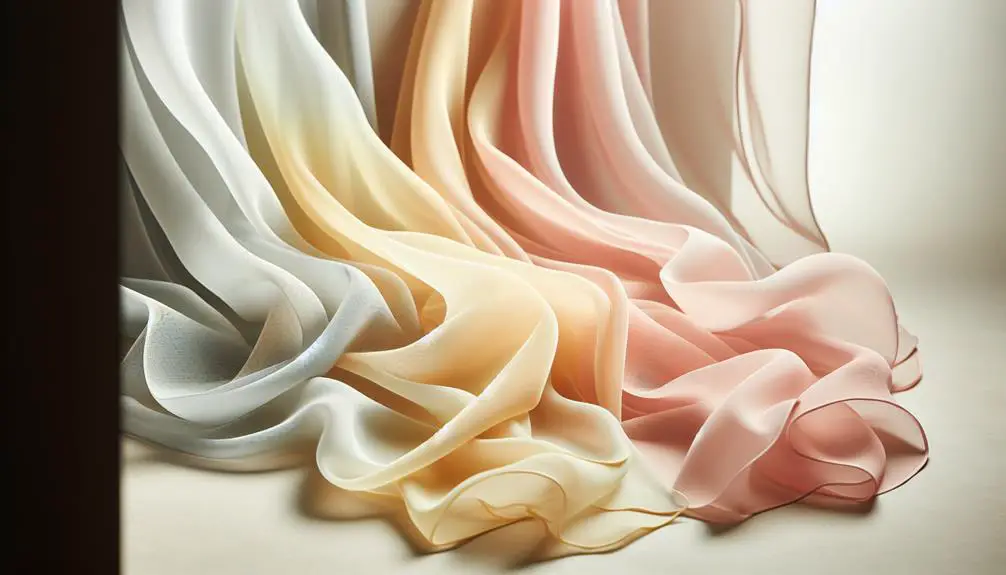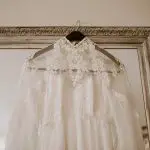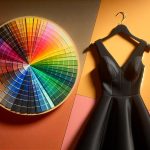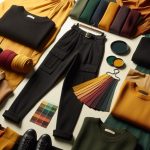When you ask about the color of chiffon, you're dipping into a rainbow of options. Chiffon isn't tied to a specific color; it comes in a whole spectrum, from classic neutrals like white, black, and ivory, to vibrant reds, deep blues, and even soft pastels. These options make chiffon versatile for any fashion need or event theme, adapting effortlessly to seasonal trends and personal tastes. Whether it's a romantic wedding ensemble or a bold party dress, there's a chiffon shade that fits the bill. And I've got more intriguing details on just how each color transforms an outfit.
Table of Contents
Key Takeaways
- Chiffon is available in a wide range of colors, including soft pastels, vibrant hues, and classic shades like white and black.
- Common colors for chiffon include delicate lavenders, bright reds, deep blues, and earth tones like rich burgundies.
- The fabric's color versatility makes it suitable for various occasions, from weddings to formal events and casual gatherings.
- Seasonal trends influence chiffon colors, with pastels popular in spring and vibrant or deep tones in summer and fall.
- Chiffon color choices often reflect current fashion trends, psychological effects, and the intended use of the garment.
Understanding Chiffon Fabric
Chiffon is a lightweight, sheer fabric known for its elegant drape and soft, silky texture. I've worked with it extensively in my designs, and I've learned that its unique qualities stem from the way it's made. Chiffon is typically woven from silk, polyester, or nylon, and it features a fine mesh-like weave that gives it a transparent appearance. This weave is what allows chiffon to drape so beautifully, making it a favorite for evening wear and bridal gowns.
One of the things I appreciate most about chiffon is its versatility. Despite its delicate appearance, it's surprisingly strong, thanks to the twists in the yarns used during the weaving process. These twists create slight puckers in the fabric, which are responsible for its slight stretch and textured feel. Handling chiffon can be tricky, though. It's slippery and can fray easily if not handled correctly. When I'm working with chiffon, I always make sure to use sharp scissors and fine needles to prevent damaging the fabric.
Understanding these characteristics of chiffon not only helps in selecting the right type for your project but also in achieving the best results in your final product.
Common Colors of Chiffon
In my experience working with this fabric, chiffon comes in a wide array of colors, ranging from soft pastels to vibrant hues. It's fascinating how the fabric's sheer and lightweight nature can adapt to such a diverse palette. Classic colors like white, ivory, and black are perennial favorites, especially in the realms of bridal wear and evening gowns. These colors offer a timeless appeal, making them a safe choice for those staple pieces in your wardrobe.
However, don't underestimate the power of bolder shades. Bright reds, deep blues, and even neon colors are commonly used to make a statement. These shades work wonderfully for summer dresses or flowy blouses that stand out in a crowd. Pastels such as baby pink, light lavender, and pale blue are particularly popular in spring collections, reflecting the gentle, fresh vibe of the season.
For those who adore earth tones, chiffon doesn't disappoint. You'll find everything from rich burgundies to muted olives, catering to a more subdued but equally elegant palette. Each color brings its own mood and character to garments, giving designers and wearers the chance to experiment with different aesthetics and personal styles.
Selecting the Right Chiffon Color
Choosing the right chiffon color can be tricky, but I'm here to help you navigate through the latest color trends and expert matching techniques.
Whether you're sewing a dress or picking out curtains, knowing what colors are in vogue can really make your project stand out.
We'll also cover how to pair colors to create the most visually appealing combinations.
Chiffon Color Trends
To stay on trend, it's essential to select the right chiffon color that complements the current fashion season. Lately, we've seen a shift towards earthy tones and pastels. If you're aiming to be fashion-forward, think about incorporating shades like soft terracotta, muted olive, or delicate lilac into your wardrobe. These colors not only reflect contemporary trends but also offer versatility across various occasions and complement a wide range of skin tones.
Additionally, don't shy away from bold colors when the season calls for it. A vibrant turquoise or rich maroon can make a striking statement piece. I always watch runway shows and read up on designer forecasts to keep my choices both fresh and informed.
Matching Colors Expertly
Selecting the perfect chiffon color often hinges on understanding the art of color matching. When I choose a color, I think about the event, the mood, and what flatters me most. It's not just about picking a favorite; it's about creating harmony. Here's a simple guide to get you started:
| Base Color | Complementary Color |
|---|---|
| Soft Pink | Moss Green |
| Deep Blue | Burnt Orange |
| Vibrant Yellow | Violet |
| Classic Ivory | Dark Charcoal |
| Rich Burgundy | Teal |
This table isn't just handy; it's a roadmap. Remember, the right contrast or complement can elevate your look from nice to unforgettable. Keep experimenting and trust your instincts!
Occasions for Different Chiffon Colors
Different chiffon colors can set the tone for various events, from elegant weddings to casual garden parties. When I'm planning an outfit or coordinating decorations, I consider the mood and setting before choosing a chiffon color. For weddings, soft pastels like blush pink or baby blue create a romantic atmosphere, especially for spring and summer ceremonies. White chiffon, of course, remains a classic choice for bridal gowns and veils.
For more formal occasions, such as gala dinners or prestigious award ceremonies, I lean towards richer hues. Deep navy, classic black, or a bold burgundy lend a touch of sophistication and elegance. These colors work well in luxurious, flowing chiffon fabrics that reflect light beautifully under evening lights.
Conversely, for casual events like garden parties or beach gatherings, I prefer light, airy colors. Bright yellows, vibrant corals, and soothing aqua tones bring a playful, relaxed vibe. These colors in chiffon are perfect for daytime events where the sun can highlight their cheerfulness.
Choosing the right chiffon color isn't just about personal taste—it's about enhancing the event's theme and ensuring that everything flows seamlessly. Whether it's a formal gathering or a relaxed meet-up, the color of chiffon I pick plays a crucial role in setting the perfect scene.
Trends in Chiffon Colors
I've noticed that the trends in chiffon colors for 2023 are quite exciting.
We're seeing a shift with seasonal color variations that really reflect the time of year.
Moreover, influential designers are making bold choices that are setting the pace for what's fashionable.
Popular Chiffon Colors 2023
As we step into 2023, soft pastels and vibrant jewel tones are dominating the chiffon color trends. These hues aren't just catching eyes; they're crafting moods and setting the stage for this year's fashion narratives. Think delicate lavenders, soothing aqua, rich emerald, and bold ruby. These colors aren't randomly picked; they reflect a broader trend towards both comfort and luxury in fashion.
Emerald green, for example, conveys a sense of opulence and has been all over runways, likely because it pairs beautifully with a range of skin tones and accessories. On the softer side, pastel pink continues to be a favorite for its versatility, working equally well for formal wear and casual outfits. These colors are essentials for anyone looking to update their wardrobe with chiffon this year.
Seasonal Color Variations
While popular chiffon colors like emerald green and pastel pink define this year's trends, seasonal variations also play a significant role in how these colors are perceived and used.
In spring, lighter shades like lavender and sky blue dominate, mirroring the soft, fresh ambiance of the season.
As we move into summer, vibrant hues such as bold coral and sunny yellow take center stage, reflecting the energetic, upbeat mood.
Come autumn, earthy tones like rust and olive become more prominent, aligning with the more subdued, cozy atmosphere.
Finally, winter calls for deeper, richer colors such as burgundy and navy, which resonate well with the colder, more introspective time of year.
Each season subtly shifts the palette, ensuring chiffon remains stylishly relevant.
Influential Designers' Choices
Many top designers are now embracing unusual shades of chiffon, setting bold new trends for the fashion industry.
I've noticed that more are leaning towards muted, earthy tones which seem to offer a fresh perspective on the usual brights and pastels. This shift isn't just about aesthetics; it's about challenging the norms and making a statement.
For instance, the recent collections showcased at major fashion weeks featured chiffon in shades like deep moss green and dusty rose, which are typically reserved for heavier fabrics. This choice isn't random; it's a deliberate move to blend seasonal versatility with high fashion.
Designers are pushing boundaries, and it's thrilling to see how they're using chiffon to do it.
Color Psychology in Chiffon
Exploring the color psychology of chiffon, I've noticed that different hues can significantly affect our mood and perceptions. For instance, when you wear a soft pastel chiffon, it doesn't just serve its purpose as a lightweight, flowy fabric; it also projects a sense of calm and gentleness. These pastel tones tend to evoke a nurturing vibe, making them perfect for occasions where you want to appear approachable and caring.
On the other hand, if you choose a vibrant red chiffon, you're tapping into its power to energize and command attention. Red is often associated with passion and confidence. Wearing a red chiffon dress can make you feel more dynamic and assertive, which is ideal for events where making a bold statement is key.
Similarly, opting for a deep blue chiffon can help communicate reliability and strength. It's a color often linked with depth and stability, which is why you might choose it for business meetings or situations where you need to project trustworthiness and professionalism.
Understanding these nuances allows you to use chiffon not just as a fashion statement, but as a tool for personal expression and psychological influence. Choosing the right color can align your external appearance with your internal intentions, enhancing how you're perceived in various social contexts.
Caring for Colored Chiffon
Now, let's talk about how to keep your colored chiffon looking great.
I'll cover everything from the best wash techniques to proper drying and storage methods.
Plus, I'll show you how to safely iron your chiffon garments to avoid damage.
Wash Techniques for Chiffon
To keep your colored chiffon vibrant, it's essential to master proper wash techniques. First off, always check the care label. If it says 'hand wash,' don't toss it in the machine. I like to use cold water to prevent color bleeding. A mild detergent designed for delicate fabrics is your best bet; it's gentle and helps maintain the fabric's integrity.
I gently agitate the fabric by hand, letting the soap work its magic without being too rough. Rinse it thoroughly in cold water to remove any soap residue. Remember, never wring out chiffon; it can damage the fibers. Instead, I just press the water out gently. By following these steps, you're ensuring your chiffon stays as stunning as the day you bought it.
Drying and Storage Tips
After washing your colored chiffon, it's important to dry and store it correctly to maintain its beauty.
I always lay my chiffon flat to air dry, away from direct sunlight to prevent fading. Hanging can cause deformation, so flat drying keeps the shape intact.
Once dry, I gently fold the chiffon, placing it in a cool, dry drawer. I avoid using plastic bags for storage, as they can trap moisture, leading to mildew. Instead, I opt for fabric garment bags which allow the material to breathe. This method not only preserves the vibrant colors but also prevents any unwanted creases.
Ironing Colored Chiffon Safely
Ironing colored chiffon requires a gentle touch to avoid damaging its delicate fabric. I always make sure my iron is set to the lowest heat setting because high temperatures can melt or distort chiffon.
I've found that using a pressing cloth between the iron and the chiffon is crucial. It protects the fabric from direct heat and prevents any potential shine or scorch marks. I also avoid sliding the iron across the fabric. Instead, I lift and press in sections to minimize stretching.
Patience is key here; rushing can lead to mishaps. Lastly, I always check the garment's care label before starting. Some colored chiffons may have specific ironing instructions or might be better off steamed.
Pairing Colors With Chiffon
While chiffon itself is versatile, choosing the right colors to pair with it can truly enhance your outfit's overall appeal. I've found that the key to mastering the art of pairing colors with chiffon lies in understanding its sheer, lightweight nature and how it interacts with light. When you're selecting complementary colors, think about balance and harmony.
For instance, pairing a soft pastel chiffon blouse with neutral bottoms creates a subtle, sophisticated look. I prefer beige or light gray trousers to maintain the delicacy of the chiffon's texture and color. On the other hand, if you're looking to make a statement, bold colors like deep red or navy can set off a lighter shade of chiffon beautifully. It's all about creating contrast without overwhelming the fabric's inherent airiness.
When mixing patterns with chiffon, I stick to simple designs. A striped or lightly floral pattern can complement a solid chiffon piece without clashing. Remember, chiffon's charm is in its simplicity and flow, so it's best not to overcomplicate your outfit with too many competing elements.
Ultimately, mastering chiffon color pairings enhances your style subtly but significantly. By keeping balance and fabric interaction in mind, you'll craft outfits that are both appealing and appropriate.
Seasonal Chiffon Colors
As the seasons change, so do the ideal chiffon colors to complement the shifting environment. In spring, I'm all about embracing soft pastels. Think delicate shades like lavender, mint green, and pale pink. These colors mirror the gentle awakening of nature and work wonderfully for light, airy outfits that float beautifully in the spring breeze.
Summer calls for vibrant, punchy colors. I reach for bold turquoise, bright coral, and sunny yellow chiffons. These shades aren't just eye-catching but also reflect summer's energetic vibe. They're perfect for beach parties or sunny outdoor events where you want to stand out.
When fall rolls around, I switch to richer, deeper tones. Mustard yellow, burnt orange, and deep teal chiffons echo the colors of falling leaves and provide a warm contrast to the cooling temperatures. These colors lend themselves well to layered looks, which are essential as the weather cools.
Winter chiffon colors? I go for elegance with deep blues, emerald greens, or rich burgundies. These hues are striking against snowy backdrops and pair beautifully with heavier fabrics in layered ensembles. This approach keeps the material relevant and stylish, regardless of the cold.
Chiffon in Bridal Wear
In bridal wear, chiffon is beloved for its ethereal and delicate appearance, making it a top choice for everything from flowing gowns to subtle accents. I've seen its magic firsthand in countless weddings. The way chiffon drapes and shimmers under soft lighting adds an undeniable touch of romance and grace. It's not just the look; the feel of chiffon is light and airy, which is perfect for brides who want comfort without compromising on elegance.
Chiffon's versatility is showcased in various bridal applications. Here's a quick rundown:
| Use in Bridal Wear | Description |
|---|---|
| Wedding Gowns | Often used for layers; it creates a soft, flowing silhouette that flatters without adding weight. |
| Bridesmaid Dresses | Perfect for achieving a cohesive look with lightness and movement, allowing for color consistency in various hues. |
| Veils | Provides a sheer, lightweight cover that complements any dress without overshadowing intricate details. |
| Decorative Details| Ideal for adding delicate touches to dresses, such as ruffles or flower appliques, enhancing the gown's texture and depth.
Mastering the use of chiffon can dramatically elevate the overall aesthetic of a wedding ensemble. It's about understanding its properties and integrating them thoughtfully into the bridal vision.
Chiffon in Everyday Fashion
Beyond its elegance in bridal wear, I find chiffon equally charming in everyday fashion, where it offers a touch of softness and sophistication to regular outfits. This fabric isn't just for those high-end occasions; it has a versatile appeal that fits seamlessly into your daily wardrobe. Whether it's a breezy chiffon blouse paired with jeans for a casual lunch or a soft, flowing skirt that elevates a simple office look, chiffon brings a unique blend of comfort and class.
What really makes chiffon stand out in everyday fashion is its ability to adapt. It's lightweight enough for a summer's day, yet can be layered for cooler weather without feeling bulky. I love experimenting with colors and patterns in chiffon. From pastel shades for a soft, romantic vibe to bold prints that make a statement, the possibilities are endless.
Chiffon also drapes beautifully, which is why I often choose it for tops and dresses. It flatters the figure without clinging too tightly, providing a graceful silhouette that moves with you. It's this combination of practicality and elegance that makes chiffon a staple in my wardrobe for both everyday wear and special occasions.
Future of Chiffon Colors
Looking ahead, I'm excited to see how the color trends for chiffon will evolve in the fashion world. The dynamic nature of fashion means that chiffon can adapt to emerging trends while maintaining its classic elegance. Innovations in dye technology and shifting cultural influences are set to usher in a vibrant spectrum of hues that could redefine our conception of this beloved fabric.
Here's a peek at what might be on the horizon:
| Trend Influence | Expected Colors |
|---|---|
| Environmental Awareness | Earthy tones like forest green and sandy beige |
| Technological Advances | Metallic shades and iridescent finishes |
| Cultural Shifts | Bold patterns and multicultural motifs |
These influences aren't just random; they're a direct response to global trends. As environmental concerns continue to grow, I expect to see more natural and understated colors that reflect a collective consciousness towards sustainability. On the flip side, technological enhancements could introduce us to more futuristic and experimental colors, possibly even responsive dyes that change color based on light or temperature! Lastly, as the world becomes more interconnected, the influence of diverse cultures will likely bring about a mix of traditional and innovative colors that reflect global aesthetics. What an exciting time to follow the evolution of chiffon colors!
Frequently Asked Questions
How Does UV Exposure Affect Chiffon Fabric Colors?
UV exposure often fades chiffon fabric colors, making them less vibrant over time. I've noticed that prolonged sunlight can alter the hues significantly, especially in lighter shades that are more susceptible to damage.
Are There Hypoallergenic Dyes for Coloring Chiffon?
Yes, there are gentle dyes specially formulated for those with sensitive skin. I've found that these hypoallergenic options work well on chiffon, ensuring vibrant colors without irritating my skin.
Can Chiffon Be Dyed Using Natural Ingredients?
Yes, I've successfully dyed chiffon using natural ingredients like turmeric and beetroot. It's eco-friendly and can yield vibrant results, though colorfastness might vary. Always test on a small piece first!
What Is the Carbon Footprint of Producing Colored Chiffon?
Interestingly, I've just been reading about textile production's environmental impact. Producing colored chiffon significantly increases its carbon footprint due to the dyeing process, especially if synthetic dyes are used over natural options.
How Does Water Quality Impact Chiffon Dyeing Processes?
Water quality greatly affects how chiffon is dyed; impurities can alter color consistency and absorption. I've found that using purified water ensures more vibrant and uniform hues during the dyeing process.
- Tetron Fabric for Marine Applications: Durability and Use Cases - June 18, 2025
- Tetron Fabric for Outdoor Furniture: Weather Resistance and Care - June 18, 2025
- Tetron Fabric for Wall Coverings: Style and Application Tips - June 18, 2025






